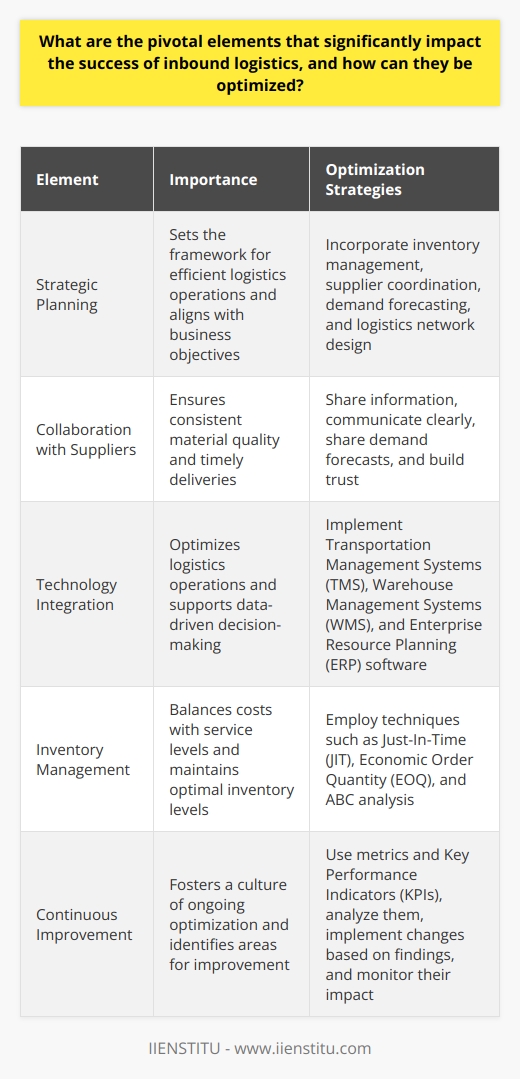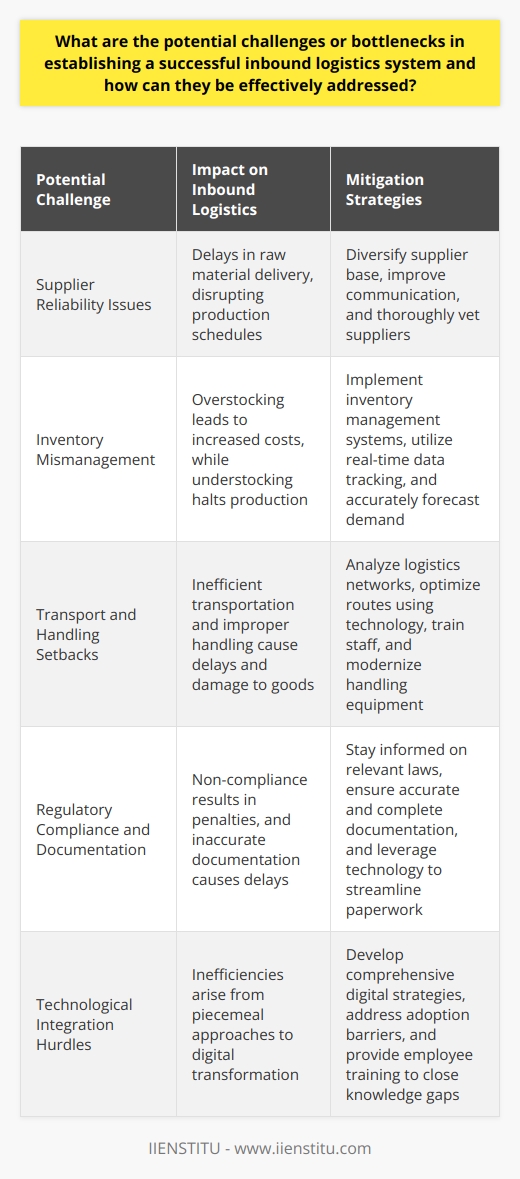
In the complex ballet of supply chain functions, inbound logistics plays a crucial part - quietly ensuring that the gears of procurement and material management whirl smoothly. Often eclipsed by the more visible outbound logistics, the movement and storage of materials entering the business demand meticulous attention to secure a firm's operational foundation. This blog digs into the essence of inbound logistics, highlighting its indispensable place within the supply chain.
By understanding its definition, appreciating its significance, and capturing the objectives involved in its management, readers will gain actionable insights into the cogs of successful inbound logistics. With the burgeoning interest in logistics management course offerings and the proliferation of online courses, professionals can harness knowledge and tactics to infuse efficacy into their inbound supply chains.
The Role of Inbound Logistics in Supply Chains
Inbound logistics can be likened to the roots of a tree – veiled beneath the surface, yet essential for sustenance and growth. It encapsulates the procurement operations, from the sourcing of raw materials to the strategic positioning of inventory before production commences.
Supplier Relationship Management
Managing relationships with suppliers transcends beyond negotiation. It is about forging partnerships that ensure materials are not only cost-effective but of impeccable quality and delivered punctually. The efficacy of inbound logistics is often mirrored in how well a company collaborates with its suppliers – a harmonious partnership resulting in a leaner, more responsive supply chain.
Warehousing & Storage
Strategic warehousing and storage form the physical core of inbound logistics. The movement of materials within the warehouse, their storage configurations, and the overall facility location impact both cost and efficiency. Warehousing decisions must reflect the sensitive balance between having enough stock to buffer against demand fluctuations, without succumbing to the financial drain of overstocking.
Inventory Management
Central to inbound logistics is inventory management – the fine art of sustaining optimal stock levels that satisfy production without inflating costs. It requires a deft blend of forecasting, responsiveness, and adaptability to market conditions. With precise inventory management, businesses can evade both deficits and surpluses, thereby maintaining a seamless operational cadence.
In sum, to overlook the role of inbound logistics is to risk the very foundation upon which businesses secure customer satisfaction and profitability. Its synergy with outbound logistics is apparent, framing the entirety of a firm’s supply chain activities from supplier to end-user.
Challenges in Managing Inbound logistics
Navigating inbound logistics is akin to steering through a dynamic and occasionally treacherous sea. The challenges are manifold, ranging from disruptions in the supplier's milieu to managing the intricate dance of material movement and storage.
Route Optimization and Timing
Consider the critical aspect of route optimization and timing – a puzzle that requires continuous tweaking to avoid delays and capitalize on cost-savings. Disturbances in this area ripple through the supply chain, underscoring the importance of agile and strategic planning. Missteps in timing or routing can escalate costs and clog the supply channel, leading to delays downstream.
Dealing with Suppliers
Interactions with suppliers, if not managed adeptly, can lead to strained relationships or even severance, potentially crippling the inflow of essential inputs. Differences in culture, expectations, and communication can tarnish the rapport with suppliers, underlining the need for robust, clear, and respectful engagement strategies.
Case Studies
Moreover, real-world examples abound wherein companies have triumphed over such adversities. By analyzing these case studies, businesses can glean insights into effective tactics for converting challenges into operational excellence. For instance, a case study might showcase how a retailer overcame port congestion by re-routing shipments and collaborating closely with alternative suppliers, ensuring an uninterrupted flow of goods.
Strategies for Effective Inbound Logistic Management
If the challenges of inbound logistics are the storm clouds, then the strategies developed to manage these challenges are the silver linings. To weather the tempest, companies invest in smart strategies, adapting with each ebb and flow.
Implementing Advanced Technologies for Inbound Logistics
The integration of technology stands out as an essential strategy. Deploying advanced software for tracking and analytics can streamline operations, elevating both transparency and efficiency. Technological advancements like AI-driven forecasting tools facilitate better demand planning and inventory accuracy.
Supplier Management Strategies
Equally paramount are strategic initiatives like establishing clear communication protocols with suppliers and creating a supplier evaluation system, thereby promoting transparency and nurturing mutually beneficial relationships. This approach is particularly crucial in the wake of globalization and increased reliance on international suppliers, shaping a more resilient inbound logistics framework.
Inventory Control Techniques
When implementing inventory control techniques, businesses can opt for Just-In-Time (JIT) inventory systems or apply ABC analysis to prioritize stock management efforts. Each technique must be tailored to suit the specific leanings and objectives of the enterprise, cushioning against disruptors while providing flexibility and agility.
Businesses yearning to thrive must not only adopt but adapt these strategies, molding them to fit their unique processes and market contexts.
Future Trends of Inbound Logistics
The horizon of inbound logistics is continually expanding – offering new vistas through emerging technologies and shifting market dynamics.
Emerging Trends and Technologies
Predictive analytics, the Internet of Things (IoT), and blockchain are but a few innovations redefining the landscape. These technologies promise to amplify the precision and velocity at which inbound logistics operates. As data becomes increasingly pivotal, companies that leverage analytics for decision-making are poised to gain a significant edge.
Impact Assessment
The impact of these trends cannot be overstated, as they promise to refurbish logistic strategies and amplify efficiency. By staying abreast of such developments, companies can ensure relevancy and competitiveness within ever-evolving markets.
Preparedness for Future Developments
Business leaders are stewarding the future by not only acknowledging these trends but also by crafting adaptive strategies and investing in workforce capabilities. It is essential to remain agile and forward-thinking, focusing on continuous learning and process enhancements, thus positioning for tomorrow's possibilities.
Conclusion
Through the analytical lens of this blog, we have surveyed the essential aspects of inbound logistics. From its pivotal role in the supply chain to the sundry challenges and inventive strategies that enhance its efficiency, inbound logistics is the linchpin of successful business operations.
Moreover, by envisioning the future trends that lie on the cusp of transforming inbound logistics, companies can preemptively position themselves favorably. Effective management of inbound logistics has shown to fortify business success, proving indispensable in transcending mere survival to thriving in today's market.
In closing, the call to action for businesses is unequivocal: realize the profound influence of inbound logistics and commit to mastering its components. By doing so, enterprises can assure not only their immediate effectiveness but their long-term relevancy in the competitive global marketplace.

Frequently Asked Questions
What are the pivotal elements that significantly impact the success of inbound logistics, and how can they be optimized?
Understanding Inbound Logistics
Inbound logistics involves incoming goods management. It is critical for efficient operations. Manufacturers, retailers, and distributors all rely on effective inbound logistics. Several key elements shape its success.
Strategic Planning
Strategic planning sets the logistics framework. It aligns with business objectives. Companies must plan meticulously. Effective strategies incorporate inventory management and supplier coordination. They also account for demand forecasting and logistics network design.
Collaboration with Suppliers
Close supplier ties are essential. They ensure consistent material quality. They also guarantee timely deliveries. Collaboration involves sharing information. Both parties must communicate clearly. They must also share demand forecasts. Trust is the cornerstone of this relationship.
Technology Integration
Modern technology optimizes logistics operations. Important technologies include:
- Transportation Management Systems (TMS)
- Warehouse Management Systems (WMS)
- Enterprise Resource Planning (ERP) software
These systems support data-driven decision-making. They improve process efficiency. They also enhance visibility across the supply chain.
Process Standardization
Standard processes create consistency. They reduce errors. They also cut costs. Standardization is key for training employees. It ensures everyone follows best practices. Audit these processes regularly. Adjust them as necessary.
Inventory Management
Effective inventory management balances costs with service levels. Excess stock ties up capital. Insufficient stock causes delays. Employ techniques such as:
- Just-In-Time (JIT)
- Economic Order Quantity (EOQ)
- ABC analysis
These techniques help maintain optimal inventory levels.
Transportation Efficiency
Transportation is a cost driver. Optimize route planning. Use fuel-efficient vehicles. Consolidate shipments when possible. Employ backhauling to minimize empty miles.
Regulatory Compliance
Regulations affect logistics operations. Comply with customs requirements. Abide by transportation rules. Meet environmental standards. Non-compliance leads to fines. It also affects brand reputation.
Continuous Improvement
Adopt a culture of continuous improvement. Use metrics and Key Performance Indicators (KPIs). Analyze them to identify areas for improvement. Implement changes based on findings. Monitor their impact.
Sustainability Practices
Sustainability is increasingly important. Sustainable practices include:
- Reducing carbon footprint
- Using renewable energy sources
- Minimizing waste
Sustainable logistics attracts eco-conscious customers. It also prepares businesses for future regulations.
Employee Training and Development
Well-trained staff is crucial. Training enhances performance. It minimizes mishandlings. Invest in your workforce. Promote ongoing learning.
Contingency Planning
Disruptions are inevitable. Develop contingency plans. These plans address potential disruptions. They ensure business continuity. Adaptability is key in crisis management.
In conclusion, careful attention to these elements fosters successful inbound logistics. Optimizing them requires commitment. It also requires a willingness to invest in best practices and technologies. Successful inbound logistics provide a competitive edge. They also ensure customer satisfaction and loyalty.

How does efficient inbound logistics management contribute to overall business performance and customer satisfaction?
Efficient Inbound Logistics Management
Boosts Business Performance
Inbound logistics management stands crucial. It encompasses procurement, storage, and transportation. Companies ensure timely availability of materials. Efficient practices reduce costs. They streamline processes. These strategies improve operational efficiency. Notably, lower costs translate to competitive pricing.
Businesses gain from better inventory management. Overstocking leads to high holding costs. Understocking causes production delays. Optimal inventory balances both extremes. Thus, inventory turnover improves. Resources get utilized well.
Enhances Customer Satisfaction
Quality logistics bring customer delight. Short lead times become possible. Customers receive products faster. Stock availability meets customer demand. This ensures prompt service. Consistency in supply builds trust. Reliability in order fulfillment promises satisfaction.
Improves Supplier Relationships
Strong supplier partnerships emerge from efficient management. Coordination with suppliers smoothes operations. Communication remains key in these partnerships. Shared information helps in planning. Problems get addressed swiftly. Mutual understanding leads to better service.
Logistics efficiency supports lean strategies. Waste in the system reduces. Agile responses to market changes occur. Thus, businesses maintain competitive edges.
Fosters Sustainability
Sustainability efforts gain a boost. Efficient logistics mean less waste. They encourage responsible resource use. Fuel consumption decreases. Carbon footprint goes down. Businesses align with green initiatives.
Increases Transparency
Real-time tracking technologies grow more common. Visibility across the supply chain grows. Stakeholders track inbound shipments easily. Issues get identified early. Managers make informed decisions. Transparency leads to accountability.
Enables Continuous Improvement
Data analytics drives performance improvements. Patterns in logistics get analyzed. Insights guide operational enhancements. Continuous monitoring identifies areas for improvement. Companies adapt and evolve. Strategies get refined through regular review.
Efficient inbound logistics management thus becomes indispensable. It supports robust business performance. It ensures high customer satisfaction. It strengthens supplier relationships. Sustainability and transparency benefit as well. Continuous improvement becomes a natural outcome. Businesses thrive through such effective logistics practices.

What are the potential challenges or bottlenecks in establishing a successful inbound logistics system and how can they be effectively addressed?
The Complexity of Inbound Logistics
Inbound logistics forms the backbone of any supply chain. It concerns raw materials' and components' procurement, handling, and transportation to a manufacturer or business. Effective inbound logistics ensures seamless operations. Yet, complexities abound.
Supplier Reliability Issues
Supply chain resilience is vital. Suppliers must deliver on time. Delays disrupt the entire chain. Diverse supplier bases mitigate this risk. Companies must vet suppliers thoroughly. A focus on communication strengthens relationships.
Inventory Mismanagement Risks
Inventory levels demand careful control. Too much stock incurs costs. Too little halts production. Inventory management systems offer solutions. Real-time data tracking improves decision-making. Companies must forecast demand accurately. Forecasting avoids overstocking or stockouts.
Transport and Handling Setbacks
Transportation proves critical in logistics. Efficient transport ensures timely deliveries. Traffic snarls and route issues pose challenges. Companies should analyze logistics networks. Technological tools optimize routes and save time. Handling requires equal attention. Improper handling damages goods, causing losses. Staff training becomes essential. Equipment modernization aids in mishap reduction.
Regulatory Compliance and Documentation
Regulations govern inbound logistics. Compliance is non-negotiable. Firms must stay informed on laws. Non-compliance results in penalties. Documentation must be accurate and complete. Technology aids in streamlining this paperwork.
Technological Integration Hurdles
Technology drives modern logistics. Yet, digital transformations are complex. Systems must integrate seamlessly. A piecemeal approach leads to inefficiencies. Businesses need comprehensive digital strategies. Adoption barriers must be addressed. Employee training closes the knowledge gap.
Mitigation through Strategy and Technology
italicInbound logistics calls for strategic thinking.italic Companies must anticipate challenges. BoldStrategies must include risk management.Bold Partnerships and collaborations unlock efficiency. Adaptability to market fluctuations maintains flow. Technologies like AI and IoT offer advantage.
In conclusion, several potential bottlenecks can impede a successful inbound logistics system. These include supplier reliability issues, inventory mismanagement, transport and handling setbacks, regulatory non-compliance, and problems with technological integration. Businesses can address these challenges by diversifying supplier bases, employing robust inventory management systems, optimizing transportation networks, ensuring up-to-date knowledge of compliance requirements, and embracing comprehensive digital transformation strategies. Effective management of these potential challenges ensures a resilient and efficient inbound logistics system, which is essential for maintaining a competitive edge in today's market.



